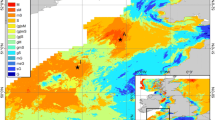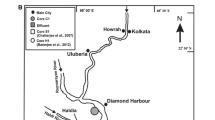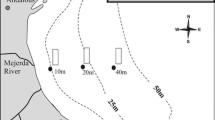Abstract
Dissolved and solid-phase speciation of Mn and Fe was measured in the porewaters of sediments recovered from three sites in the Greater St. Lawrence Estuary: the Saguenay Fjord, the Lower St. Lawrence Estuary (LSLE) and the Gulf of St. Lawrence (GSL). At all sites and most depths, metal organic ligand complexes (Mn(III)–L and Fe(III)–L) dominated the sedimentary porewater speciation, making up to 100% of the total dissolved Mn or Fe. We propose that these complexes play a previously underestimated role in maintaining oxidized soluble metal species in sedimentary systems and in stabilizing organic matter in the form of soluble metal–organic complexes. In the fjord porewaters, strong (log KCOND > 13.2) and weak (log KCOND < 13.2) Mn(III)–L complexes were detected, whereas only weak Mn(III)–L complexes were detected at the pelagic and hemipelagic sites of the GSL and LSLE, respectively. At the fjord site, Mn(III)–L complexes were kinetically stabilized against reduction by Fe(II), even when Fe(II) concentrations were as high as 57 μM. Only dissolved Mn(II) was released from the sediments to overlying waters, suggesting that Mn(III) may be preferentially oxidized by sedimentary microbes at or near the sediment–water interface. We calculated the dissolved Mn(II) fluxes from the sediments to the overlying waters to be 0.24 µmol cm−2 year−1 at the pelagic site (GSL), 11 µmol cm−2 year−1 at the hemipelagic site (LSLE) and 2.0 µmol cm−2 year−1 in the fjord. The higher benthic flux in the LSLE reflects the lower oxygen concentrations (dO2) of the bottom waters and sediments at this site, which favor the reductive dissolution of Mn oxides as well as the decrease in the oxidation rate of dissolved Mn(II) diffusing through the oxic layer of the sediment and its release to the overlying water.



Similar content being viewed by others
References
Annane S, St-Amand L, Starr M, Pelletier E, Ferreyra GA (2015) Contribution of transparent exopolymeric particles (TEP) to estuarine particulate organic carbon pool. Mar Ecol Prog Ser 529:17–34
Anschutz P, Sundby B, Lefrançois L, Luther GWI, Mucci A (2000) Interaction between metal oxides and the cycles of nitrogen and iodine in bioturbated marine sediments. Geochim Cosmochim Acta 64:2751–2763
Anschutz P, Dedieu K, Desmazes F, Chaillou G (2005) Speciation, oxidation state, and reactivity of particulate manganese in marine sediments. Chem Geol 218:265–279
Barbeau C, Bougie R, Côté J-E (1981) Variations spatiales et temporelles du cesium-137 et du carbone dans les sédiments du fjord du Saguenay. Can J Earth Sci 18:1004–1011
Beckler JS, Jones ME, Taillefert M (2015) The origin, composition, and reactivity of dissolved iron(III) complexes in coastal organic- and iron-rich sediments. Geochim Cosmochim Acta 152:72–88
Bélanger C (2003) Observation and modelling of a renewal event in the Saguenay Fjord. Ph.D. thesis, Université du Québec à Rimouski, Rimouski, QC
Belley R, Archambault P, Sundby B, Gilbert F, Gagnon J-M (2010) Effects of hypoxia on benthic macrofauna and bioturbation in the Estuary and Gulf of St. Lawrence, Canada. Cont Shelf Res 30:1302–1313
Belzile M, Galbraith PS, Bourgault D (2015) Water renewals in the Saguenay Fjord. J Geophys Res 121:638–657
Benoit P, Gratton Y, Mucci A (2006) Modeling of dissolved oxygen levels in the bottom waters of the Lower St. Lawrence Estuary: coupling of benthic and pelagic processes. Mar Chem 102:13–32
Boyle EA, Edmond JM, Sholkovitz ER (1977) The mechanism of iron removal in estuaries. Geochim Cosmochim Acta 41:1313–1324
Brendel PJ, Luther GW (1995) Development of a gold amalgam voltammetric microelectrode for the determination of dissolved Fe, Mn, O2, and S(-II) in porewaters of marine and freshwater sediments. Environ Sci Technol 29:751–761
Canfield DE, Jorgensen BB, Fossing H, Glud R, Gundersen J, Ramsing NB, Thamdrup B, Hansen JW, Nielsen LP, Hall POJ (1993) Pathways of organic carbon oxidation in three continental margin sediments. Mar Geol 11:27–40
Chaillou G, Schafer J, Anschutz P, Lavaux G, Blanc G (2003) The behaviour of arsenic in muddy sediments of the bay of Biscay (France). Geochim Cosmochim Acta 67:2993–3003
Chen Q, Mucci A, Sundby B, Minarik W (2012) Early diagenesis of redox-sensitive elements in the Estuary and Gulf of St. Lawrence. Contributed poster presentation, 22st V.M. Goldschmidt Conference, June 24–29, Montréal, Canada. Mineralogical Mag 76:1568
Chester R, Hughes MJ (1967) A chemical technique for the separation of ferro-manganese minerals, carbonate minerals and adsorbed trace elements from pelagic sediments. Chem Geol 2:249–262
Davies SHR, Morgan JJ (1989) Manganese(II) oxidation kinetics on metal oxide surfaces. J Colloid Interface Sci 129:63–77
Dellwig O, Schnetger B, Brumsack H, Grossart H, Umlauf L (2012) Dissolved reactive manganese at pelagic redoxclines (part II): hydrodynamic conditions for accumulation. J Mar Syst 90:31–41
Dickie L, Trites RW (1983) The Gulf of St. Lawrence. In: Dickie L, Trites RW (eds) Estuaries and semi-enclosed seas. Elsevier Scientific Publication, Amsterdam, pp 403–425
Duckworth OW, Sposito G (2005) Siderophore-manganese(III) interactions I. Manganite dissolution promoted by desferrioxamine-B. Environ Sci Technol 39:6045–6051
Duckworth OW, Sposito G (2007) Siderophore-promoted dissolution of synthetic and biogenic layer type Mn oxides. Chem Geol 242:497–508
Edenborn HM, Mucci A, Belzile N, Lebel J, Silverberg N, Sundby B (1986) A glove box for the fine scale subsampling of sediment box cores. Sedimentology 33:147–150
El-Sahb MI, Silverberg N (1990) The St. Lawrence Estuary: introduction. In: El-Sabh MI, Silverberg N (eds) Oceanography of a large-scale estuarine system. Springer, New York, pp 1–9
Ferdelman G (1988) The distribution of sulfur, iron, manganese, copper, and uranium in a salt marsh sediment core as determined by a sequential extraction method. M.Sc. thesis, University of Delaware
Fortin GR, Pelletier M (1995) Synthèse des connaissances sur les aspects physiques et chimiques de l’eau et des sédiments du Saguenay. Environnement Canada, région du Québec, Conservation de l’environnement, Centre Saint-Laurent, Technical report
Froelich PN, Klinkhammer GP, Bender ML, Luedtke NA, Heath GR, Cullen D, Dauphin P, Hammond D, Hartman B, Maynard V (1979) Early oxidation of organic matter in pelagic sediments of the eastern equatorial Atlantic, suboxic diagenesis. Geochim Cosmochim Acta 43:1075–1090
Gagnon C, Mucci A, Pelletier E (1995) Anomalous accumulation of acid-volatile sulphides in a coastal marine sediment (Saguenay Fjord, Canada). Geochim Cosmochim Acta 59:2663–2675
Gaillard J-F, Pauwels H, Michard G (1989) Chemical diagenesis in coastal marine sediments. Oceanol Acta 12:175–187
Genovesi L, de Vernal A, Thibodeau B, Hillaire-Marcel C, Mucci A, Gilbert D (2011) Recent changes in bottom water oxygenation and temperature in the Gulf of St. Lawrence: micropaleontological and geochemical evidence. Limnol Oceanogr 56:1319–1329
Gilbert D, Gobeil C, Sundby B, Mucci A, Tremblay GH (2005) A seventy-two year record of diminishing deep-water oxygen levels in the St. Lawrence estuary: the northwest Atlantic connection. Limnol Oceanogr 50:1654–1666
Gratton Y, Mertz G, Gagné JA (1988) Satellite observations of tidal upwelling and mixing in the St. Lawrence Estuary. J Geophys Res 93(C6):6947–6954
Gratton Y, Lefaivre D, Couture M (1994) Océanographie physique du fjord du Saguenay. Le fjord du Saguenay: Un Milieu Exceptionnel de Recherche, J.-M. Sévigny and C. M. Couillard, Eds., Ministère des Pêches et des Océans, Institut Maurice-Lamontagne, pp 8–16
Hansard SP, Easter HD, Voelker BM (2011) Rapid reaction of nanomolar Mn(II) with superoxide radical in seawater and simulated freshwater. Environ Sci Technol 45:2811–2817
Hedges JI, Keil RG (1995) Sedimentary organic matter preservation: an assessment and speculative synthesis. Mar Chem 49:81–115
Hyacinthe C, Bonneville S, Van Cappellen P (2006) Reactive iron(III) in sediments: chemical versus microbial extractions. Geochim Cosmochim Acta 70:4166–4180
Katsev S, Chaillou G, Sundby B, Mucci A (2007) Effects of progressive oxygen depletion on sediment diagenesis and fluxes: a model for the lower St. Lawrence River Estuary. Limnol Oceanogr 52:2555–2568
Kostka J, Luther GW (1994) Partitioning and speciation of solid phase iron in salt-marsh sediments. Geochim Cosmochim Acta 58:1701–1710
Learman DR, Voelker BM, Vazquez-Rodrigues AI, Hansel CM (2011) Formation of manganese oxides by bacterially generated superoxide. Nat Geosci 4:95–98
Lefort S (2012) Multidisciplinary study of hypoxia in the deep water of the Estuary and Gulf of St. Lawrence: is this ecosystem on borrowed time? Ph.D. thesis, McGill University
Lefort S, Mucci A, Sundby B (2012) Sediment response to 25 years of persistent hypoxia. Aquat Geochem 18:461–474
Leventhal J, Taylor C (1990) Comparison of methods to determine degree of pyritization. Geochim Cosmochim Acta 54:2621–2625
Lin H, Szeinbaum NH, DiChristina TJ, Taillefert M (2012) Microbial Mn(IV) reduction requires an initial one-electron reductive solubilization step. Geochim Cosmochim Acta 99:179–192
Locat J, Levesque C (2009) Le Fjord du Saguenay: Une physiographie et un registre exceptionnel. Rev Sci Eau 22:135–157
Luther GW (2010) The role of one- and two-electron transfer reactions in forming thermodynamically unstable intermediates as barriers in multi-electron redox reactions. Aquat Geochem 16:395–420
Luther GW, Kostka JE, Church TM, Sulzberger B, Stumm W (1992) Seasonal iron cycling in the salt-marsh sedimentary environment: the importance of ligand complexes with Fe(II) and Fe(III) in the dissolution of Fe(III) minerals and pyrite, respectively. Mar Chem 40:81–103
Luther GWI, Shellenbarger PA, Brendel PJ (1996) Dissolved organic Fe(III) and Fe(II) complexes in salt marsh porewaters. Geochim Cosmochim Acta 60:951–960
Luther GW, Sundby B, Lewis BL, Brendel PJ, Silverberg N (1997) Interactions of manganese with the nitrogen cycle: alternative pathways to dinitrogen. Geochim Cosmochim Acta 61:4043–4052
Luther GW, Glazer BT, Ma S, Trouwborst RE, Moore TS, Metzger E, Kraiya C, Waite TJ, Druschel G, Sundby B, Taillefert M, Nuzzio DB, Shank TM, Lewis BL, Brendel PJ (2008) Use of voltammetric solid-state (micro)electrodes for studying biogeochemical processes: laboratory measurements to real time measurements with an in situ electrochemical analyzer (ISEA). Mar Chem 108:221–235
Luther GW III, Madison AS, Mucci A, Sundby B, Oldham VE (2015) A kinetic approach to assess the strengths of ligands bound to soluble Mn(III). Mar Chem 173:93–99
Luther GW, Thibault de Chanvalon A, Oldham VE, Estes EE, Tebo BM, Madison AS (2018) Reduction of manganese oxides: thermodynamic, kinetic and mechanistic considerations for one- versus two-electron transfer steps. Aquat Geochem 24:257–277. https://doi.org/10.1007/s10498-018-9342-1
Madison AS, Tebo BM, Luther GW (2011) Simultaneous determination of soluble manganese(III), manganese(II) and total manganese in natural (pore)waters. Talanta 84:374–381
Madison AS, Tebo BM, Mucci A, Sundby B, Luther GW III (2013) Abundant porewater Mn(III) is a major component of the sedimentary redox system. Science 341:875–878
Mucci A (2004) The behavior of mixed Ca–Mn carbonates in water and seawater: controls of manganese concentrations in marine porewaters. Aquat Geochem 10:139–169
Mucci A, Richard L-F, Lucotte M, Guignard C (2000) The differential geochemical behavior of arsenic and phosphorus in the water column and sediments of the Saguenay Fjord Estuary, Canada. Aquat Geochem 6:293–324
Mucci A, Boudreau B, Guignard C (2003) Diagenetic mobility of trace elements in sediments covered by a flash flood deposit: Mn, Fe and As. Appl Geochem 18:1011–1026
Oldham VE, Owings SM, Jones M, Tebo BM, Luther GW (2015) Evidence for the presence of strong Mn(III)-binding ligands in the water column of the Chesapeake Bay. Mar Chem 171:58–66
Oldham VE, Mucci A, Tebo BM, Luther GW (2017a) Soluble Mn(III)-L complexes are abundant in oxygenated waters and stabilized by humic ligands. Geochim Cosmochim Acta 199:238–246
Oldham VE, Miller MT, Jensen LT, Luther GW (2017b) Revisiting Mn and Fe removal in humic rich estuaries. Geochim Cosmochim Acta 209:267–283
Oldham VE, Tebo BM, Jones MR, Luther GW (2017c) Oxidative and reductive processes contributing to manganese cycling at oxic-anoxic interfaces. Mar Chem 195:122–128
Parker D, Sposito G, Tebo BM (2004) Manganese(III) binding to a pyoverdine siderophore produced by a manganese(II)-oxidizing bacterium. Geochim Cosmochim Acta 68:4809–4820
Parker DL, Morita T, Mozafarzadeh ML, Verity R, McCarthy JK, Tebo BM (2007) Inter-relationships of MnO2 precipitation, siderophore-Mn(III) complex formation, siderophore degradation, and iron limitation in Mn(II) oxidizing bacterial cultures. Geochim Cosmochim Acta 71:5672–5683
Raiswell R, Canfield DE, Berner RA (1994) A comparison of iron extraction methods for the determination of degree of pyritisation and the recognition of iron-limited pyrite formation. Chem Geol 111:101–110
Reeburgh WS (1967) An improved interstitial water sampler. Limnol Oceanogr 12:163–165
Schafer CT, Smith JN, Côté R (1990) The Saguenay Fjord: a major tributary to the St. Lawrence Estuary. In: El-Sabh MI, Silverberg N (eds) Oceanography of a large-scale estuarine system: The St. Lawrence, vol 39. Springer, New York, pp 378–420
Schulz HD (2000) Quantification of early diagenesis: dissolved constituents in marine porewaters. In: Shulz HD, Zabel M (eds) Marine geochemistry. Springer, Berlin
Silverberg N, Sundby B (1990) Sediment-water interaction and early diagenesis in the Laurentian Trough. In: El-Sabh MI, Silverberg N (eds) Oceanography of a large-scale estuarine system: The St. Lawrence, vol 39. Springer, New York, pp 202–238
Silverberg N, Bakker J, Edenborn HM, Sundby B (1987) Oxygen profiles and organic carbon fluxes in Laurentian Trough sediments. Neth J Sea Res 21:95–105
Smith JN, Schafer CT (1999) Sedimentation, bioturbation, and Hg uptake in the sediments of the estuary and Gulf of St. Lawrence. Limnol Oceanogr 44:207–219
Smith JN, Walton A (1980) Sediment accumulation rates and geochronologies measured in the Saguenay Fjord using the Pb-210 dating method. Geochim Cosmochim Acta 44:225–240
Stacey MW, Gratton Y (2001) The energetics and tidally induced reverse renewal in a two-silled fjord. J Phys Oceanogr 31:1599–1615
Stookey LL (1970) Ferrozine. A new spectrophotometric reagent for iron. Anal Chem 42:770–781
Stumm W, Morgan JJ (1996) Aquatic chemistry. Wiley-Interscience, New York, p 1022
Sundby B (1977) Manganese-rich particulate matter in a coastal marine environment. Nature 270:417–419
Sundby B, Silverberg N, Chesselet R (1981) Pathways of manganese in an open estuarine system. Geochim Cosmochim Acta 45:293–307
Taillefert M, Bono AB, Luther GW (2000) Reactivity of freshly formed Fe(III) in synthetic solutions and (pore)waters: voltammetric evidence of an aging process. Environ Sci Technol 34:2169–2177
Taillefert M, Rozan TF, Glazer BT, Herszage J, Trouwborst RE, Luther WG III (2002) Seasonal variations of soluble organic-Fe(III) in sediment porewaters as revealed by voltammetric microelectrodes. In: Taillefert M, Rozan T (eds) Environmental electrochemistry: analyses of trace element biogeochemistry. American Chemical Society Symposium Series, Chapt 13, vol 811. American Chemical Society, Washington, DC, pp 247–264. https://doi.org/10.1021/bk-2002-0811.ch013
Tebo BM, Ghiorse WC, vanWaasbergen LG, Siering PI, Caspi R (1997) Review in mineralogy. Miner Soc Am 35:225–266
Tebo BM, Johnson HA, McCarthy JK, Templeto AS (2005) Geomicrobiology of manganese(II) oxidation. Trends Microbiol 13:421–428
Thibodeau B, de Vernal A, Mucci A (2006) Recent eutrophication and consequent hypoxia in the bottom waters of the Lower St. Lawrence Estuary: micropaleontological and geochemical evidence. Mar Geol 231:37–50
Tremblay L, Gagné J-P (2007) Distribution and biogeochemistry of sedimentary humic substances in the St. Lawrence Estuary and the Saguenay Fjord, Québec. Org Geochem 38:682–699
Trouwborst RE, Clement B, Tebo BM, Glazer BT, Luther GW III (2006) Soluble Mn(III) in suboxic zones. Science 313:1955–1957
Van Cappellen P, Wang Y (1996) Cycling of iron and manganese in surface sediments: a general theory for the coupled transport and reaction of carbon, oxygen, nitrogen, sulfur, iron and manganese. Am J Sci 296:197–243
van den Berg CMG (1995) Evidence for organic complexation of iron in seawater. Mar Chem 50:139–157
Webb SM, Dick GJ, Bargar JR, Tebo BM (2005) Evidence for the presence of Mn(III) inermediates in the bacterial oxidation of Mn(II). Proc Natl Acad Sci USA 102:5558–5563
Yakushev EV, Pollehne F, Jost G, Kuznetsov I, Schneider B, Umlauf L (2007) Analysis of the water column oxic/anoxic interface in the Black and Baltic seas with a numerical model. Mar Chem 107:388–410
Yakushev E, Pakhomova S, Sørenson K, Skei J (2009) Importance of the different manganese species in the formation of water column redox zones: observations and modeling. Mar Chem 117:59–70
Acknowledgements
This work was funded by grants from the Chemical Oceanography program of the National Science Foundation (OCE-1558738 and OCE-1155385 to GWL; OCE-1558692 and OCE-1154307 to BMT) and the National Sciences and Engineering Research Council of Canada (NSERC) through Discovery and Ship-time grants to AM. Véronique Oldham thanks the University of Delaware for receipt of a Marian R. Okie Fellowship and a University of Delaware Graduate Fellowship. Thanks also to Gilles Desmeules as well as the captain and crew of the R/V Coriolis II who made sampling for this research possible. Finally, we thank the journal reviewers, including D. Burdige, and the Associate Editor, B. Deflandre for their incisive comments and recommendations.
Author information
Authors and Affiliations
Corresponding author
Additional information
Publisher's Note
Springer Nature remains neutral with regard to jurisdictional claims in published maps and institutional affiliations.
Rights and permissions
About this article
Cite this article
Oldham, V.E., Siebecker, M.G., Jones, M.R. et al. The Speciation and Mobility of Mn and Fe in Estuarine Sediments. Aquat Geochem 25, 3–26 (2019). https://doi.org/10.1007/s10498-019-09351-0
Received:
Accepted:
Published:
Issue Date:
DOI: https://doi.org/10.1007/s10498-019-09351-0




